|
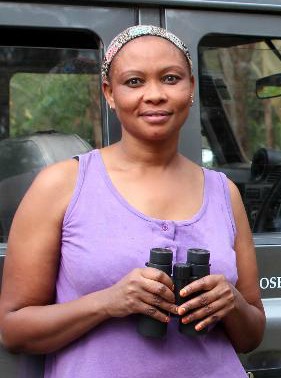
Katito Sayialel asks you to Donate Now
|
|
How Many Calves Now?
| |
The first calf sighted in the record-breaking 2011-2012 Amboseli baby boom was born on October 12, 2011. Qumquat's daughter has just reached her first birthday and we consider that this marks the cut-off for this particular baby boom.
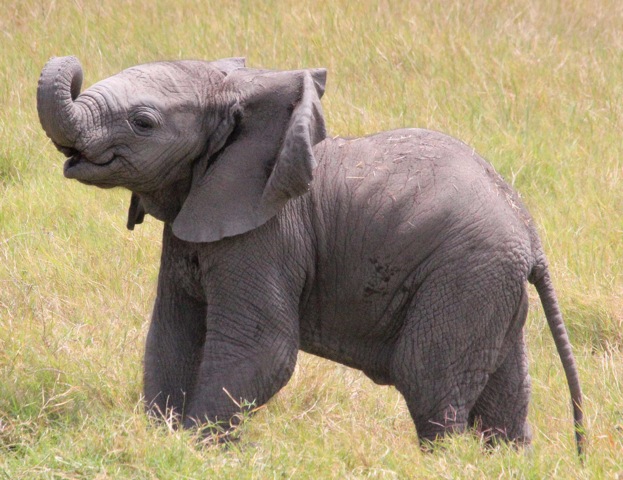 | |
Elspeth's calf was number 201, born at the end of August
|
She and all the calves born since were conceived in 2010. From now on the new calves will have been conceived in 2011.
In total we have recorded 224 calves born in a period of one year. This is an amazing number considering that there were only 444 adult females over the age of 10 when the drought ended and some had calves already. It shows how adaptable and resilient elephants can be.
Don't forget that ATE has a naming program and that you can name one of these calves and followed its life: Naming
|
|
|
Illegal Killing Update
| |
Although poaching of elephants for ivory is still rampant in Africa, Amboseli has lost only a few elephants in the last two months. This state of affairs is mainly due to the work of the Amboseli Tsavo Game Scouts supported by the Big Life Foundation.
We are relieved to report that the political upheaval over revenue sharing between the Maasai and the Kenya Wildlife Service has been resolved and all has been quiet on that front.
|
|
Changes at KWS
| |
After eight years of service, Julius Kipng'etich, the Director of the Kenya Wildlife Service resigned at the end of September. He has since taken up the position of CEO of Equity Bank in Kenya. We wish him well in his new endeavor. He leaves behind a much-improved organization devoted to the conservation of natural ecosystems and wildlife.
A new Director has been appointed. He is Mr. William Kibet Kiprono, who was previously a County Commissioner.
|
|
Visit from REA
| |
Thomas Topfer, the Director of Rettet die Elefanten Afrikas e.V., visited us in Amboseli in late August. Based in Germany, REA is a remarkable organization in that no one is paid a salary. They all work as volunteers including Thomas and are generous and consistent donors to several elephant projects in Africa.
Last year REA donated two top-end Canon cameras to ATE. With one of these Robert Ntawuasa has been making videos for our YouTube channel. The other is used for our calf naming program and elephant IDs.
This year Thomas came again with donations. He brought a small but excellent sound recorder and a stabilized lens for Robert. He also brought GPS units for the scouts.
We have named one of the new calves REA in honor of this generous NGO.
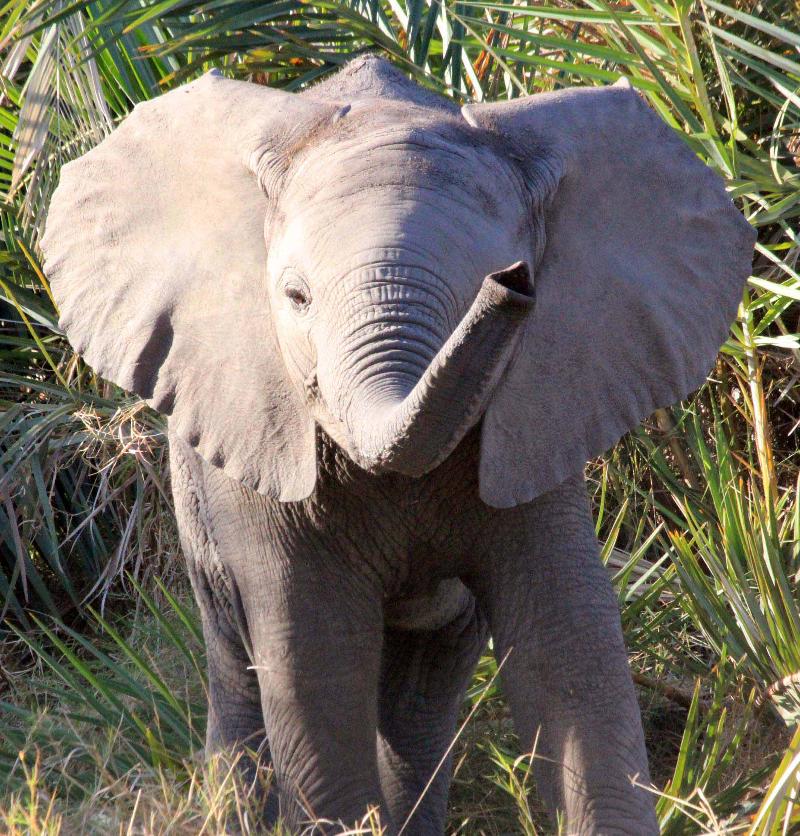 | |
Risa's daughter is named Rea and she has wonderfully large ears
|
|
|
Advocacy
| We continue to do what we can in terms of elephant advocacy. In particular we are saying yes to every journalist and filmmaker who wants to film the Amboseli elephants. We feel that they are the best ambassadors for their case.
Soila worked with a team from National Geographic led by long-time friend of ATE, John Heminway. This film will be about the illegal ivory trade and what it is doing to elephants.
Cynthia, Soila and Vicki worked with Kristen Bauer, the actress who plays Pam in the TV series "True Blood". She is making a documentary film called "Out from Africa" to try to raise consciousness of the plight of wildlife. Kristen is working closely with our partners, the International Fund for Animal Welfare.
Cynthia was interviewed and filmed by a journalist from the Australian Broadcasting Company (ABC). This film will also be featuring poaching and the ivory trade. We were pleased to hear that ABC broadcasts to the Far East including China.
|
|
Wish List
| |
There are two items we need for the project somewhat urgently. Robert Ntawuasa, our IT man and videographer, is also doing more and more field work and he doesn't have a pair of binoculars. He needs a good pair of Zeiss or Leica 10x40s.
One of our cameras used for ID photos needs to be replaced. We use Canons and need something like a Canon Rebel with a 100-300mm lens.
Is there a donor, or donors, out there who could help us?
|
|
Give a Gift that Lives Forever
| | |
Include ATE in your bequest and estate planning. For a brochure on how to do that, contact Betsy Swart in our US office at: eswart@elephanttrusts.org.
|
|
ATE YouTube Videos
| |
The Amboseli Trust for Elephants has its own channel on YouTube. Check out our latest videos: Here
*News Flash*: Robert and Vicki's video on the rescue of Zombe's calf has gone viral (Find link to the video in the story of the rescues above). This short film has had over 290,000 views on YouTube and thousands more on other sites. Journalists are calling for interviews. We're thrilled because it's one more way to bring attention to elephants.
We are also pleased that people want to help. One way you can do so is to send a donation to help us elephant-proof the wells. We've fixed several of them so far but we need more funds to continue with the construction.
|
|
Archive of Past Newsletters
|
The past issues of the ATE newsletter can be found on our website: Newsletter Archive |
|
|
News from the Amboseli Trust for Elephants
September-October 2012
|
Greetings!
We are very busy in the ATE office in Nairobi preparing for a big celebration of the 40th Anniversary of the Amboseli Elephant Research Project. It will take place in two phases, the first on November 23rd in Nairobi National Park at the Ivory Burning memorial site and the second in December in Amboseli National Park. KWS kindly and generously offered to co-host the event and we are working closely together on all the preparations. I will report on both events in the next issue of the newsletter.
In this letter, however, I want to say thank you to everyone who has helped us keep this project going for such a long time. AERP is the longest-running elephant research project in the world and its results have had a profound influence on people's knowledge of and attitudes towards elephants. Our studies, films, books and lectures have opened up the world of elephants to a wider public, and we believe that public understands and cares much more about elephant conservation and welfare than it did 40 years ago.
We could not have created this awareness without friends, donors, mentors, universities, government agencies, NGOs, and many more. Thank you. Let's hope we can keep AERP going for many more years, at least for the full life span of a single elephant.
Cynthia Moss
DirectorAmboseli Trust for Elephants |
|
|
Calf Rescues
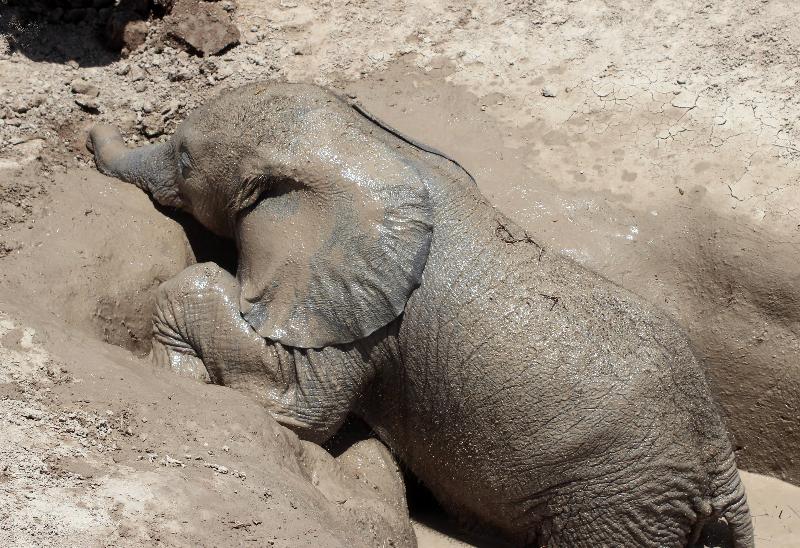
| | The calf named Lemoyian stuck in a well |
At the end of the dry season when there is little water outside the central Amboseli swamps, the elephants use the Maasai wells dug for livestock. These wells often have steep, deep sides and baby elephants can fall in and then get stuck.
Back in 2009, we developed and put in place several designs to make wells 'calf-proof' -- see the story at Sinya Wells Not a Danger Anymore -- but since then old wells have been abandoned, new ones dug.
In the space of a few weeks the ATE team has had to rescue three calves from wells. In two of the cases the mothers were frantically trying to extricate their calves when the team arrived. This kind of situation presents problems because the mother has to be chased and kept away before a rescue is possible.
The first of this series of rescues occurred at the end of August. Soila, Katito, Vicki and Robert went to the rescue. It was almost dark when they got there. They found a young mother from the WB family with an older calf and a six-month old calf struggling to get out. They pushed the mother away and immediately got a rope around the calf and pulled it out. As soon as the calf was out it gave a massive roar and the mother came running back and they all went off into the dark.
The second rescue was at a different well and again the mother, this time recognizable in the daylight as Zombe from the ZAs, was trying to help the calf out. There was another older juvenile with her but they weren't having any success. This time Soila and Vicki had to chase the mother away, but Zombe is a big female and she did not want to abandon her little daughter. She almost sat on the Land Rover but eventually gave in and moved off. Now there were only two people to pull the calf out--Robert and Fulbright scholar Mark Sowers. It was very difficult to get the rope around the calf. As Soila held Zombe at bay, Vicki in the second Land Rover waited to pull the calf with the vehicle. This calf was big and heavy at eight months old. They finally succeeded and like the other calf this one gave a massive roar and headed off running flat out towards where he could hear is mother calling. Robert and Vicki managed to get video of this whole process and the final footage of the calf and mother reuniting is extraordinarily moving. See the amazing video of the rescue of Zombe's calf
The third rescue occurred the very next day in the same well, but, unfortunately, there were no other elephants around. A very concerned Maasai man, Muterian ole Saboti, had stayed with the calf the whole morning to make sure that young boys didn't spear him. He is a true hero. The ATE team (on this day it was Soila, Cynthia, Vicki and Robert) plus a vehicle and help from Tortilis Lodge went out to the well. This calf was young, only about three months o
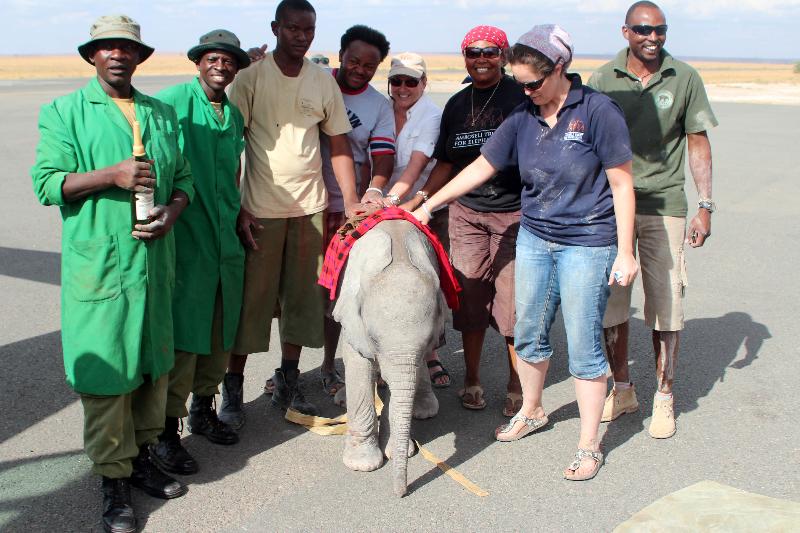 | |
Lemoyian with his rescuers from the David Sheldrick Wildlife Trust, ATE and Tortilis Lodg
|
ld and it was simple to get him out. The problem was what to do with him. After talking to the Senior Warden it was decided that he would have to be sent to the David Sheldrick Wildlife Trust orphanage in Nairobi to be raised there. We managed to get him in the back of our Land Rover and met the DSWT plane at the airstrip. The keepers immediately gave the calf, now called Lemoyian for the area where he was found, bottles of milk and water which he drank in seconds. After treating him with antibiotics and ointment for his eyes, he had to be tied down for a second time and put on the plane. Although we hate to lose calves from Amboseli population in this way, we know Lemoyian is in very good hands and we have had reports that he has settled down and made friends with the other orphans.
|
| Fulbright Scholar
We are very please to welcome Mark Sowers to the ATE team. Mark has an unusual history. He has had a passion for elephants since he was a boy. At 10 years old he started following the research and work of ATE. Whenever he could he would raise money for us. None of that is extraordinary but what is unusual is that Mark never gave up his dream of one day studying elephants. When boys are 10 years they want to be firemen or football players or astronauts with plans changing from month to month, but it never changed for Mark. He remained dedicated to elephants. Now at 22 years old his dream has come true.
When he was 15 years old Mark visited Amboseli for the first time with his father. He came back with his mother another year and when he was old enough he came on his own. Earlier this year his whole family visited Kenya and learned what it was that Mark has remained so loyal to. In the meantime he went to university and got a degree in biology from Kansas State University this past June.
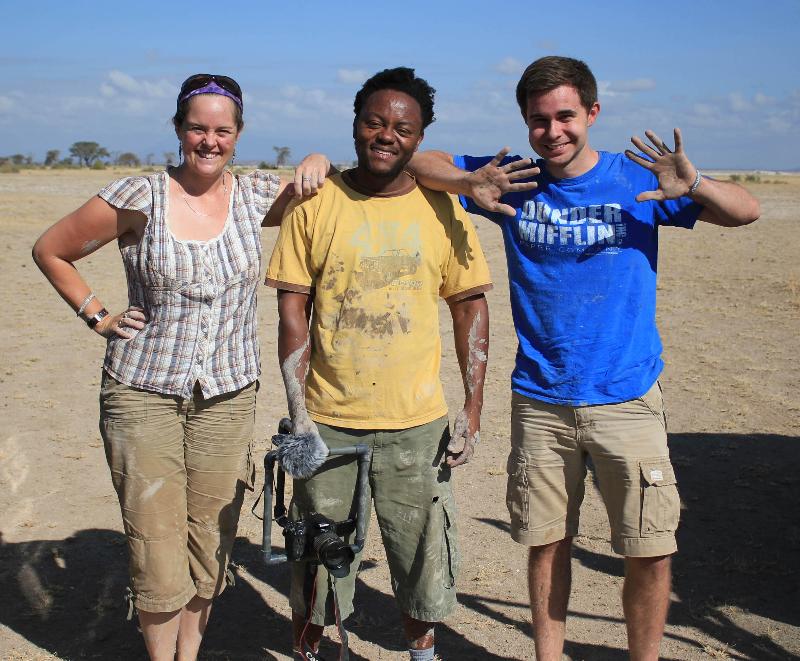 | | Mark Sowers on right with Vicki and Robert after the rescue of Zombe's calf; sometimes GIS has to taken second place |
For his Fulbright study Mark will be analyzing the data on five collared female elephants in the Amboseli population. (Click here to see the collaring in action.) These females are from five different families and they were chosen because they range in different areas. The collaring was carried over a year ago in July 2011 so Mark will have a good GIS data set to analyze. He will be looking at how ranges and movement patterns change throughout the year. His goal is to construct comprehensive maps of the ecosystem including elephant usage in relation to ecological and human factors. With these maps we will have a better of understanding of where efforts should be made to secure corridors. We are happy to have Mark on board to carry out this important work.
|
The History of the RA Family
The RA family has always been a fascinating if frustrating group. To this day I am not sure if certain animals I have given "R" names to are really members of the RA or XA families. I'm also not sure which clan area the RAs should be assigned to. The history of the RAs has not been clear and simple. 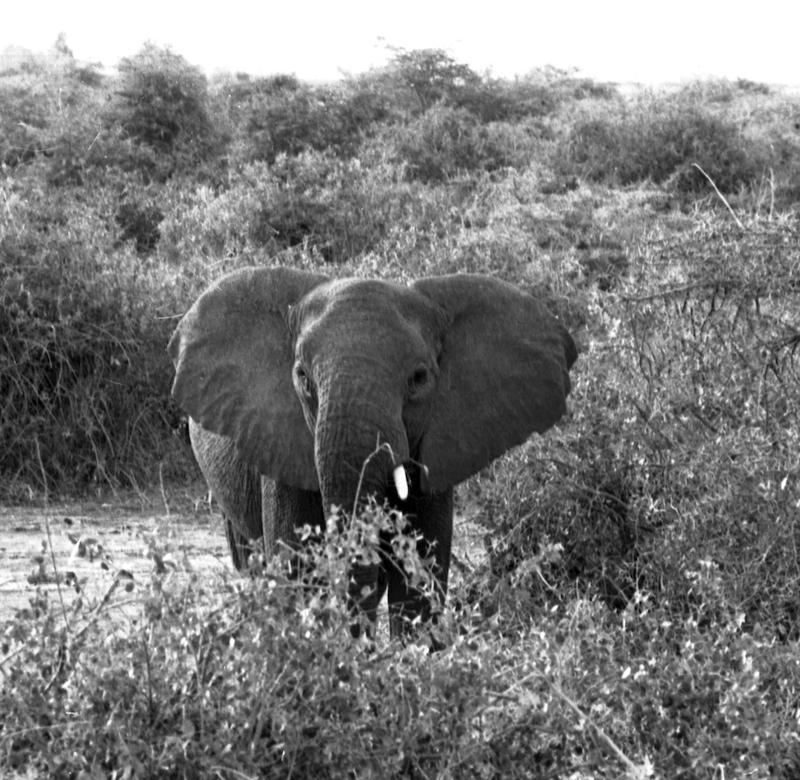 | |
The first sighting of Remedios in October 1973; peering at us from behind a bush
|
I first met the RAs' matriarch on the western side of the Park on October 5, 1973. Harvey and I were with the KA family, which was walking casually past the vehicle while he photographed them, when a left-tusked female with a five-year-old calf appeared and began demonstrating at the car. She charged,but carefully kept a large bush between herself and the car, indicating that she was not being seriously aggressive. After a couple of mock charges she peered at us from over the bush looking a little ridiculous with her one, short, left tusk. Her calf was frightened by her mother's nervousness. We managed to get some poor photographs of both of them. I saw this left-tusked female two more times that October: one time on her own at the edge of a known group and another time in a large aggregation of over 50. I only saw her twice in 1974 (this was still during the time I was in Amboseli only part-time), again once on her own near a small group and then with a large herd. Fortunately, she was easy to recognize, but no grouping or ranging pattern was emerging. Of the five times I had seen her, she was on the west side of the Park three times and on the east twice. Even though I did not know much about her I assigned her the group letter code "R" and named her Remedios. (It was at that time that I was reading Gabriel Garcia Marquez's One Hundred Years of Solitude and I liked the names in his book.) In August 1975 just before I began the full-time study, I found Remedios with a new calf about two months old. From this time on I saw Remedios regularly. She appeared to associate with a variety of animals but finally there seemed to be some consistency in the associations. Her own older calf, now seven years old, and three other young females were usually with her. I named these females Renata, Rachel and Ruth and Remedios's older calf was eventually named Rebecca.
To read the whole history of this family go to: RA History |
Amboseli Book Chapter Summary: 6. Ecological Patterns of Variability in Demographic Rates
 In Chapter 6, Ecological patterns of variability in demographic rates, Phyllis Lee, Keith Lindsay and Cynthia Moss investigate seasonal and annual variation in rates of conception and calf mortality using 30 years of demographic data for the Amboseli population. In Chapter 6, Ecological patterns of variability in demographic rates, Phyllis Lee, Keith Lindsay and Cynthia Moss investigate seasonal and annual variation in rates of conception and calf mortality using 30 years of demographic data for the Amboseli population.
They show that conceptions are most frequent in February and May, and less frequent in October through December. Conception rates closely follow food availability provided by two months grass growth in relation to the previous rainfall. Females who conceive for the first time are less closely tied into seasonal patterns of food availability. While the Amboseli elephants' reproduction has a seasonal pattern, the year-round availability of swamp vegetation may buffer them against the severe condition loss and strict seasonality of reproduction seen elsewhere in Africa.
Between years, however, annual rates of conception for available females (those not in the first 12 months of lactation or already pregnant) were strongly suppressed by droughts. During droughts, calves under the age of nutritional independence (24 mo) were likely to die.
From Amboseli lifetable statistics the authors then examined early calf deaths in relation to the population size: with more individuals in a population, the food available to all others is expected to be reduced in a food-limited ecosystem. During years when the elephant population concentrated within the central area of its range (due to poaching pressure outside), the rate of calf mortality was positively correlated with population size.
However, after 1991, the effects of the ivory trade ban improved security outside the central well-protected area, and the elephants began to disperse more widely. With dispersal and access to additional, the effects of density on calf mortality were greatly reduced.
The dynamic and unpredictable ('non-equilibrium') Amboseli ecosystem results in pulses of population growth and decline over the very long-term. Population models need to take ecosystem variance and human-induced mortality into account in order better to understand and predict the consequences of stochastic changes on the capacity for elephant populations to persist in a changing world. Understanding the factors that contribute to variability in demographic parameters and population growth or decline, both within and between populations, is of obvious importance to conservationists and managers across the African continent.
|
|
We are proud of our 40 years of research and conservation, but we feel that we must go on for many more years. Please help us celebrate where we are now and assure the future of ATE by making a special donation in honor of the 40th anniversary.
Cynthia Moss
Amboseli Trust for Elephants |
|
|